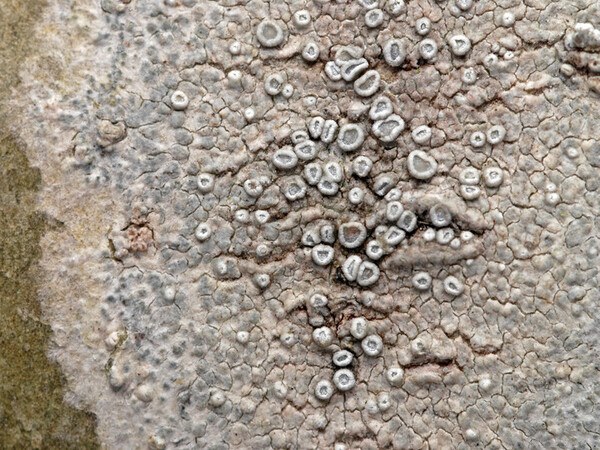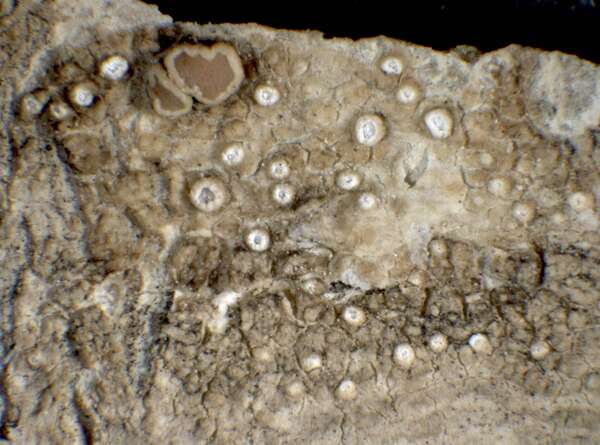Polyozosia populicola (DC.) S.Y. Kondr., Lőkös & Farkas
in Kondratyuk & al., Acta Bot. Hung., 61, 1-2: 156, 2019. Basionym: Patellaria populicola DC. in Lamarck & de Candolle - Fl. Franç., éd. 3, 2: 363, 1805.
Synonyms: Lecanora distans (Pers.) Nyl.; Lecanora populicola (DC.) Duby; Lecanora subfusca var. distans (Pers.) D. Dietr.; Myriolecis populicola (DC.) P.F. Cannon
Description: Thallus crustose, episubstratic, whitish to pale grey, continuous to rimose-areolate in central parts, often delimited by a concentrically zoned, fimbriate, pale grey prothallus, forming clearly delimited, orbicular or elliptical patches. Apothecia lecanorine, concentrated in the central parts of thallus, up to 1.5 mm across, at first immersed, later sessile and more or less constricted at base, with a pale brown to pinkish brown, usually white- or grey-pruinose (at least when young), flat disc and a prominent, white pruinose, smooth to crenulate thalline margin. Thalline exciple rich in crystals, the medulla with abundant algae; epithecium colourless to pale brown, with small crystals; hymenium colourless, 45-80 µm high; paraphyses sparingly branched, 1-2 µm thick, hardly swollen at apices; hypothecium colourless, with small granules. Asci 8-spored, elongate-clavate, very thin-walled, with a K/I+ blue, tall tholus penetrated by a faintly amyloid apical cushion, the wall K/I-, surrounded by a K/I+ blue outer layer, Lecanora-type. Ascospores 1-celled, hyaline, ellipsoid, 10-16 x 6-9 µm. Photobiont chlorococcoid. Spot tests: thallus and apothecia K-, C-, KC-, P-, UV-. Chemistry: traces of 2.5-dichlorolichexanthone.
Growth form: Crustose
Substrata: bark
Photobiont: green algae other than Trentepohlia
Reproductive strategy: mainly sexual
Commonnes-rarity: (info)
Alpine belt: absent
Subalpine belt: absent
Montane belt: very rare
Dry submediterranean belt: absent
Humid submediterranean belt: absent
Padanian area: absent
pH of the substrata:
1 2 3 4 5
Solar irradiation:
1 2 3 4 5
Aridity:
1 2 3 4 5
Eutrophication:
1 2 3 4 5
Poleotolerance:
0 1 2 3
Altitudinal distribution:
1 2 3 4 5 6
Rarity
absent
extremely rare
very rare
rare
rather rare
rather common
common
very common
extremely common
Loading data...
Occurrence data
Predictive map
Growth form: Crustose
Substrata: bark
Photobiont: green algae other than Trentepohlia
Reproductive strategy: mainly sexual
Commonnes-rarity: (info)
Alpine belt: absent
Subalpine belt: absent
Montane belt: very rare
Dry submediterranean belt: absent
Humid submediterranean belt: absent
Padanian area: absent
pH of the substrata:
| 1 | 2 | 3 | 4 | 5 |
Solar irradiation:
| 1 | 2 | 3 | 4 | 5 |
Aridity:
| 1 | 2 | 3 | 4 | 5 |
Eutrophication:
| 1 | 2 | 3 | 4 | 5 |
Poleotolerance:
| 0 | 1 | 2 | 3 |
Altitudinal distribution:
| 1 | 2 | 3 | 4 | 5 | 6 |
Rarity
absent
extremely rare
very rare
rare
rather rare
rather common
common
very common
extremely common
Loading data...
Occurrence data
Predictive map








